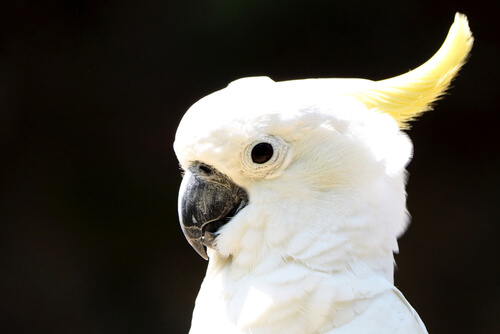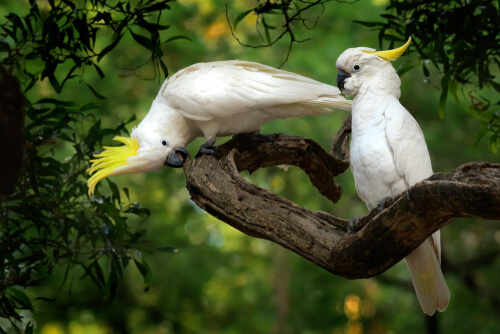
| Kingdom | Animalia |
| Phylum | Chordata |
| Class | Aves |
| Order | Psittaciformes |
| Family | Cactuidae |
| Genus | Cacatua, Probosciger, Callocephalon, Nymphicus, Calyptorhynchus, Eolophus, Lophochroa, |
| Species | Many |
| Niche | Seed disperser |
| Length | 12-24 in (30-6- cm) |
| Weight | 0.66-2.65 lbs (300-1 200 g) |
| Lifespan | 20-40+ years |
| Social Structure | Social, monogamous |
| Conservation Status | Some Vulnerable, including one Critically Endangered species |
| Preferred Habitat | Forests, mangroves |
| Average Clutch Size | 1-8 eggs |
| Main Food Items and Prey | Seeds, fruits, insects |
| Predators | Birds of prey, snakes, reptiles, small mammals |
The Basics
Cockatoo refers to any one of the 21 bird species of the family Cacatuidae. Along with two other families (Psittacoidea and Strigopoidea), they are also commonly referred to as ‘parrots’. They have a primarily Australasian range but are common in aviaries and as pets around the world as well.
Most Cockatoo species are a medium-sized bird, with defining plumage and crests. They are typically white, grey, or black along with an accompanying colored feature. This may be in the room of a colorful crest, such as in the case of the Sulphur-crested cockatoo (Cacatua galerita), or in their cheeks or tail feathers. They range in size from about 12-24 in (30-60 cm) in length and weigh between 0.66-2.65 lb (300-1 200 g).

Cockatoos have long, pointed tail feathers and a head crest that they can move. In many species, it is particularly spectacular. They all have large wings and fly well. Some galah species fly up to 43 mph (70 km/h), while species such as the sulphur-crested cockatoo have smaller, more rounded wings. This lends itself to a more leisurely flight style than their speedy cousins.
The family seems to consist of three groups or ‘clades’. The cockatiel, of the genus Nymphicus, comprises its own category, while the remaining general fall into two other primary clades. The next largest is the five species in the genus Calyptorhyncus, characterized by their black plumage. And finally, the largest category of cockatoo are those of the genus Cacatua, which is comprised of 11 white-feathered species. The remaining four genera or distinct themselves, and don’t fit well into these main groups. Cockatoos are long-lived, up to about 40 years in the wild with some individuals living to 70+ years of age in captivity.

Range and Habitat
The cockatoo’s range is relatively restricted, occurring almost solely throughout Australasia. Specifically, eleven species occur in the wild only in Australia. Seven others are restricted to the islands of the Philippines, Indonesia, Papua New Guinea, and the Solomon Islands. The three other species occur in both New Guinea and Australia. Some species have been introduced outside of their natural range, although they remain far from a cosmopolitan family of birds.
Within their range, cockatoo species occupy a relatively wide range of habitats. They can be found in subalpine forests as well as at sea level amongst the mangroves. Many species are relatively nomadic, but species that inhabit forests tend to find a productive area and stay put as food sources are more stable here in comparison to more arid habitats.
Diet
Most cockatoo species prefer to maintain a diet of seeds, fruits, and insects. They all have large bills and a muscular tongue. Combined, these help them to manipulate seeds and other food. They will often congregate with many other cockatoos in large flocks to feed. This is especially common when they are feeding on the ground, perhaps as a sort of ‘safety-in-numbers’ strategy to avoiding predation.
Nesting and Reproduction
Cockatoos tend to build their nests in tree hollows, often returning to the same spot year after year. They are unable to excavate these sites themselves, relying on insects or rotting sections of trees to do this work for them. They will then line this site with sticks and leaves and protect it aggressively, especially during the breeding season.
Cockatoos form monogamous pairs, mating only with one another for many years and often rearing their young together, although in some species females are the primary caregivers and family planners. Males will often preen the female and vice versa, as well as complete courtship displays before nesting and at the beginning of the breeding season.
Following copulation, females will lay about between 1-8 small, white eggs, depending on the species. Following an incubation period of about 20-29 days, hatchlings emerge from their eggs. 5-11 weeks later, they become fledglings, leaving the nest for the first time.
Young will spend up to one year with their parents before striking out on their own. In comparison with other bird species, sexual maturity is relatively delayed in cockatoo species, allowing them to gain the skills required before taking on the task of parenting themselves.
Threats
Cockatoo’s primary predators are birds of prey such as falcons and eagles which will attack them with their talons. Eggs and nestlings are especially vulnerable and will be eaten by many animals such as snakes, mammals, and other birds.
Like many species, habitat loss for human development is among their primary threats as well. Also, their popularity in aviaries means that they are also sought after in illegal trade markets where wild-caught birds may be sold as captive-bred. Several species of cockatoo are listed as Vulnerable or worse by the IUCN, including the critically endangered yellow-crested cockatoo.
Fun Facts about Cockatoo!
Cockatoos are charismatic and unique. They are also intelligent and, in some cases, have managed to thrive alongside humans.
A Cockatoo is a Parrot
Cockatoos comprise the family Cacatuidae and are characterized by their prominent crests as well as their curved bills. There are 7 different genera and 21 species within the family. Along with cockatoo, members of the family Psittacoidea and Strigopoidea are also referred to as parrots. All parrots have a zygodactyl foot, meaning they have toes that face forward and toes that face backward. This has a strong claw on it, allowing them to grasp onto tree branches and to eat. They all have relatively short legs and broad wings, as well.

Psittacoidea, also known as ‘true parrots’, occurs over a much larger range than cockatoos, while Strigopoidea, commonly referred to as the Kakapo or New Zealand do not overlap with cockatoos in its range. In addition to their unique crests, cockatoos are typically white, grey, or black and therefore less colorful than many other parrot species with their multicolor plumage. Cockatoo species are not known to ‘talk’ or mimic in the way that ‘true parrots’ do, but they do have a complex variety of calls that they use to communicate with each other.
In summary, all Cockatoo species are parrots but not all parrots are cockatoos. All parrots, including cockatoo, have shrill and harsh vocalizations.
Cockatoo Mini-Me
Most cockatoo species are medium-sized. However, the cockatiel is undeniably a small bird. Interestingly, it seems to have diverged phylogenetically before other cockatoo species. All cockatoos are common in aviaries. However, their needs are generally rather difficult to meet. One of the easiest species to maintain is the cockatiel and indeed is the species most commonly kept as a pet or in aviaries.
An Endangered Pest
Due to most cockatoo species’ tendency to form nests in tree hollows, habitat loss is an obvious threat to their survival. Indeed, many species are threatened in this way. However, in some cases, certain species such as sulphur-crested cockatoo can adapt well and have found alternative areas to nest in areas developed by humans. In fact, some species are even considered agricultural or urban pests in some areas.
